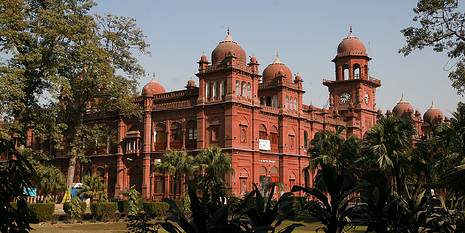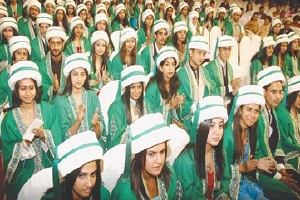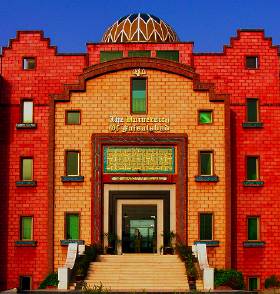Junaid Siddiqui
Last year at ATP, there was a post on the HEC (Higher Education Commission)’s Ranking of Pakistani Universities. That single post generated so much interest that in the past one year it has got 30000 hits on it. It not only shows the immense interest among prospective university students but also shows lack of career counseling or guidance available to them.

I have written this article in a hope of building further on HEC’s rankings as well as to show that Pakistani universities have very far to go to make up to any internationally recognized University Ranking.
 Spanish National Research Council biannually publishes Webometrics Ranking of World Universities. The raking is based on data obtained from popular search engines. Universities for this purpose are identified based on their institutional web domains. The methodology of ranking is based on the following quantitative indicators:
Spanish National Research Council biannually publishes Webometrics Ranking of World Universities. The raking is based on data obtained from popular search engines. Universities for this purpose are identified based on their institutional web domains. The methodology of ranking is based on the following quantitative indicators:
Size (S). Number of pages from a university’s domain recovered from search engines.
Visibility (V). The total number of unique external links received (inlinks) by a university’s site.
Rich Files (R). Number of rich files available on a university’s domain recovered from search engines. The file types considered include Adobe Acrobat (.pdf), PostScript (.ps), Microsoft Word (.doc) and Microsoft Powerpoint (.ppt). This is considered as it is relevant to academic and publication activities of a university.
Scholar (Sc). Number of papers and citations for a university’s domain available on Google Scholar.
Following formula is used to rank universities:
Webometrics Rank (position)= 4*RankV+2*RankS+1*RankR+1*RankSc
 The ranking criteria is quantitative is nature for which data can be easily obtained through some simple search engine queries. What is, however, interesting to note about the ranking results (last published in July 2007) is that they compare rather well with other world rankings of universities such as the Shanghai Jiao Tong University ranking or The Times World University Rankings.
The ranking criteria is quantitative is nature for which data can be easily obtained through some simple search engine queries. What is, however, interesting to note about the ranking results (last published in July 2007) is that they compare rather well with other world rankings of universities such as the Shanghai Jiao Tong University ranking or The Times World University Rankings.
SESRTCIC, a research center of OIC, has recently released a preliminary Academic Ranking of Universities in the OIC Countries, which is based on the research output data of the universities of OIC member states. Most of the top ranking Middle Eastern universities in the composite index of OIC ranking are also among the top Middle Eastern universities in the Webometrics ranking. The Webometrics ranking, therefore, seems to be a good indicator of global standing of a university.
Given that Webometrics ranking is based on quantitative parameters we can expect that a populous country like Pakistan should have at least few of its universities, let us say, in the top 2000. However when we look at the Webometrics ranking of Pakistani universities, it is disappointing to see that there are no universities in even top 3000 and there are only two universities in top 4000 rankings. They are Lahore University of Management Sciences (rank 3071), Aga Khan University, Karachi (rank 3422) and the Punjab University, Lahore (rank 4685).
 Universities form the centers of intellectual and scholarly activities in any country and the Webometrics ranking of our universities is an indicator of the dismal situation we have in our country. Interestingly the two universities in top 4000 (LUMS and AKU) are the same universities that Dr. Pervez Hoodbhoy identified as the two Pakistani universities closest to the universities located in free societies across the world.
Universities form the centers of intellectual and scholarly activities in any country and the Webometrics ranking of our universities is an indicator of the dismal situation we have in our country. Interestingly the two universities in top 4000 (LUMS and AKU) are the same universities that Dr. Pervez Hoodbhoy identified as the two Pakistani universities closest to the universities located in free societies across the world.
Independent thought is the foundation that allows intellectual activities to flourish which seems to be missing from the fabric of most of our higher education institutions. The recent article on BBCUrdu.com about the kind of thoughts promoted at our long established Karachi University is one example of what is happening at our universities.
Whether it be the education in the disciplines of natural sciences or social sciences the situation is the same. When we go into the classrooms what we find is an environment that restricts the thinking of our students than opening it up. This is yet another aspect of our society which needs immediate and radical measures.
About the Author: Junaid Siddiqui is a Civil Engineering graduate of NED University Karachi and now a lecturer at King Fahad University of Petroleum and Minerals.




















































Owais I agree that several simple steps can be taken to improve web presence of our universities. Realizing the value of open access to thoughts and idea and the free flow of ideas is yet another factor that makes a difference. Just look at the impact a single Blog like ATP has made. ATP has a web presence comparable to LUMS.
Pages in Yahoo at the moment
LUMS: 10, 800
http://siteexplorer.search.yahoo.com/search?p=http %3A%2F%2Flums.edu.pk&bwm=p&bwms=p&fr2=seo-rd-se
ATP: 11,300
http://siteexplorer.search.yahoo.com/search?p=http %3A%2F%2Fpakistaniat.com&bwm=p&bwms=p&fr2=seo-rd-s e
External Inlinks at the moment
LUMS: 2850
http://siteexplorer.search.yahoo.com/advsearch?p=h ttp%3A%2F%2Fpakistaniat.com&bwm=i&bwmo=d&bwmf=s
ATP: 15,800
http://siteexplorer.search.yahoo.com/advsearch?p=h ttp%3A%2F%2Fpakistaniat.com&bwm=i&bwmo=d&bwmf=s
Add some blogs to the culture of any university and it can have great impact in every sense.
Looking at the university web presence data it made me reflect that what it is that makes a good university to produce more on the web. One factor that I believe makes the real difference is the sheer amount of
Junaid, You have pointed us to a valid failure of our universities. It is very interesting how Webometrics rank universities on a formula based on their web foot mark.
As far as Webometrics is concerned, one obvious way to increase Pakistani universities ranking could be to digitize their paper research work and make it available online.
I know for Pak Engineering Universities atleast that each and every student has to work on a final project. for many students, it takes almost 18-24 months to finish this project. On many ( but not all) genuine research is performed by the students but their work all ends up in a paper form in a project library and gets ‘imprisoned’ there forever. All these final projects should be required to be available online also (atleast the abstracts/summaries). Just this step will increas Pak universities digital foot print on the web.
I agree. The budget is being mis-spent in a lot of categories. All that money should be taken away and allocated to the military budget instead so our brave soldier can kill more of us.
Reducing military budget will not ensure education budget will be spend as planned. The system needs to be improved. Its not the amount that matter, its the way that amount is spent , matters. We are a 3rd world country, but our budget doesn’t reflect that, the lavishness of the elite and ruling class burdens the budget and public bears that expense. Military budget should not be reduced when it is spent to improve the military strength, it should be reduced when it is spend for mere display of lavishness.
Furthermore, due to our corrupt system, I don’t think the allocated educational budget has been wisely used. So just allocating more and more for education will only benefit the culprits of the system, by increasing their pocket money.
:)